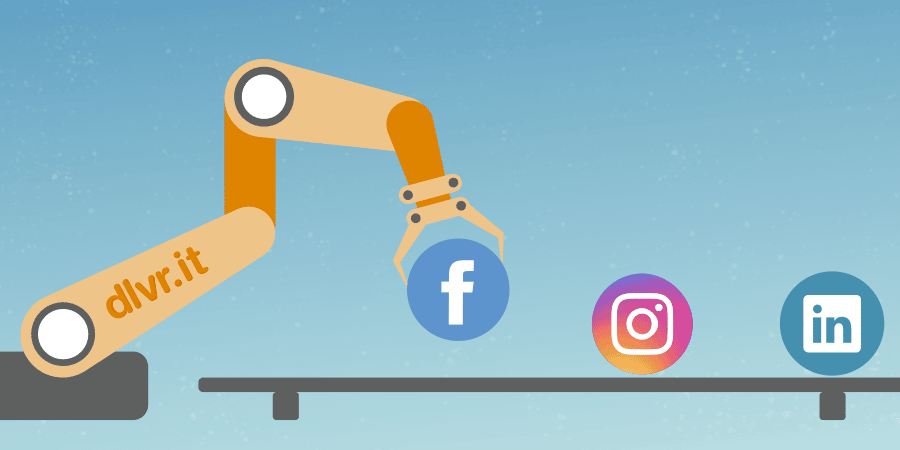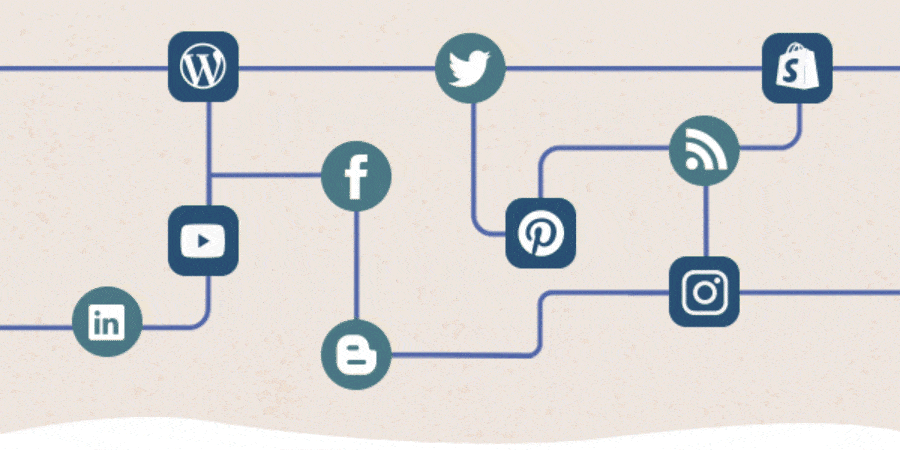
What Is Social Media Automation?
Social media automation has emerged as a prevalent method for managing your social media marketing strategy. As platforms like Facebook, Twitter, LinkedIn, Instagram, Pinterest, and YouTube evolve, a myriad of automation options exists to simplify tasks across these networks. This automation lets marketers concentrate more on business growth rather than managing posts.
For those contemplating social media automation, consider:
- Balance: Determine which tasks to automate and which to handle manually. Over-automation might diminish the personal touch, affecting audience engagement.
- Integration: Ensure your chosen automation tool seamlessly integrates with your primary social media platforms, facilitating centralized management.
- Budget: Various automation tools come at different prices. Select one that aligns with your budget and requirements.
Utilizing social media automation judiciously can help maintain a robust online presence while conserving time and effort.
A Social Media Automation Strategy For Marketers
With the influx of emails, notifications, and social media updates, automation becomes tempting. However, selecting the right tools and understanding their benefits can be challenging.
This article delves into the intricacies of automating your social media strategy. By its conclusion, you’ll comprehend automation’s essence, distinguish between automation tools, and gain insights on integrating automation into your strategy.
What Is Automation?
Wikipedia describes automation as “the practice of using computers or computer programs to perform tasks typically executed by humans.” Essentially, it’s machines taking over tasks traditionally done by people. For instance, ponder the hours invested in creating a blog post—research, planning, drafting, editing, and publishing. Now, imagine crafting a post once and letting an automated system handle publishing and promotion. That’s the power of social media automation.

Why Use Automation?
Marketers often lean on automation for scheduling and managing social interactions. Here are some compelling reasons:
- Time Savings: Manual scheduling, considering variables like time zones and holidays, can be tedious. Automation tools streamline these processes from a centralized dashboard, saving you time.
- Consistency: A frequent challenge in social media is maintaining brand consistency. With automation, you can schedule regular posts, ensuring a uniform brand message, and even enabling you to build your brand persona.
- Results: Companies employing automation often witness heightened engagement compared to those who don’t. Whether your aim is audience growth or sales boost, automation can expedite goal achievement.
Key Features of Social Media Automation Platforms:
- Schedule Posts: This feature enables marketers to plan and queue posts for automatic publication at predetermined times. The advantage of this lies in its ability to maintain consistent brand presence without daily manual input. Scheduled posts ensure timely communication with followers, aligning with events or promotions, maximizing the relevance and impact of your social media content. It also allows marketers to tap into peak engagement times, regardless of their personal availability, extending content reach and engagement.
- Auto Posting with RSS Feeds: This feature lets brands publish fresh blog content automatically across social networks using RSS feeds. The benefit is twofold: brands can consistently share new content while also ensuring that followers on all platforms get immediate access to the latest information. This automation streamlines the content sharing process, ensuring immediate distribution and increased visibility.
- Content Recycling: This feature enables brands to repurpose old blog content for fresh engagement. In the fast-paced world of social media, quality content can be overlooked. Recycling allows for the reutilization of valuable content, maximizing its reach and ensuring that new followers get exposure to previously well-received posts. It enhances content lifespan and engagement potential.
- Content Search: This feature facilitates keyword search within content, ensuring better optimization and targeting. By refining content based on popular keywords, brands can increase their content’s visibility and relevance. This proactive approach ensures that content aligns with trending topics or discussions, maximizing its reach and engagement potential.
- Import Content: This feature enables brands to utilize third-party site content and repurpose it to fit their platform. By sourcing and adapting quality content, brands can offer diverse perspectives while maintaining consistent posting schedules. This not only enriches the content pool but also positions the brand as a curator of valuable information.
- Sync Your Accounts: This feature provides automatic updates across multiple social media platforms, ensuring seamless engagement. For brands with a presence on multiple platforms, this synchronization ensures that all their accounts reflect the latest updates, promotions, or news. It streamlines management, enhances consistency, and optimizes brand image across platforms.
- Hashtag Generator: By suggesting popular hashtags, this feature enhances post visibility. In the vast realm of social media, hashtags categorize and elevate content. Using trending or relevant hashtags can significantly boost a post’s reach, tapping into wider discussions or topics and increasing brand visibility.
- Analytics Integration: This feature syncs with tools like Google Analytics, providing data-driven insights. By offering a clear view of performance metrics, brands can understand what resonates with their audience, refine strategies, and optimize content. This data-centric approach ensures informed decision-making and maximized ROI.
Advantages of Social Media Automation:
- Time-Saving: Automation significantly reduces the manual effort required in repetitive tasks. By automating certain processes, marketers can redirect their focus towards strategic planning, content creation, and other high-value activities. This optimal utilization of time enhances productivity and ensures that brands maintain a proactive approach to their online presence.
- Efficiency: Automation tools streamline operations, ensuring that brands can manage multiple accounts, platforms, and campaigns with ease. This efficiency ensures consistent brand messaging, timely updates, and a comprehensive view of the brand’s online performance, leading to more strategic and impactful campaigns.
- Accuracy: Machines, unlike humans, are less prone to errors, especially in repetitive tasks. By automating certain processes, brands minimize the risk of mistakes such as missed posts or incorrect scheduling. This accuracy ensures that the brand’s online image remains professional and trustworthy.
- Extended Reach: Automation tools often come with features that optimize post timing, hashtags, and content recycling. These features ensure that content gets shared by users and reaches a wider audience demographic, tapping into new segments and maximizing brand visibility.
- Better ROI: Automation allows marketers to focus on high-impact tasks, such as strategy formulation and content creation. By ensuring efficient management and data-driven decisions, automation optimizes resource allocation, leading to improved returns on investment.

Best Practices for Content Automation:
- Consistency: Regular posting with a tool like dlvr.it keeps the brand’s voice active and reinforces its presence in followers’ feeds. Consistent engagement ensures that the brand remains top-of-mind, fostering loyalty and trust among its audience.
- Quality: Quality is paramount in the vast sea of online content. Ensuring grammatical accuracy and value-driven content sets brands apart, showcasing their commitment to providing value to followers during their buyer journeys. Well-researched and authentic content resonates more, driving better engagement.
- Regular Monitoring: By tracking content performance, brands gain insights into audience preferences and content effectiveness. Regularly reviewing these metrics ensures that strategies remain effective and evolve with the changing digital landscape.
- Advanced Scheduling: Platforms like Hootsuite and Buffer allow for detailed content planning. This proactive approach ensures that posts align with broader brand campaigns, events, or trends, ensuring timely and relevant content delivery.
- Engagement Tracking: Responding promptly to mentions or messages enhances brand image. Immediate responses showcase the brand’s commitment to its audience, fostering trust and encouraging further engagement.
Potential Pitfalls of Automation:
- Spamming: Over-automation can lead to content that feels robotic or spammy. Followers value genuine interactions and unique content. Over-reliance on automation can dilute brand authenticity, alienating followers and diminishing trust.
- Excessive Posting: Bombarding followers with too many posts can overwhelm and annoy them. This excessive visibility can lead to unfollows or reduced engagement. Striking a balance ensures that brands remain visible without becoming intrusive.
- Incorrect Timing: Ill-timed posts might not reach their intended audience. Posting during low engagement times can bury content, reducing its visibility. Ensuring posts align with peak engagement times maximizes their reach and impact.
- Lack of Engagement: While automation streamlines processes, it shouldn’t replace human-led interactions. Failing to engage personally with followers can make the brand seem distant, reducing loyalty and trust.
- Irrelevant Content: Content that doesn’t align with brand goals or audience interests can confuse and alienate followers. It’s vital to ensure that even automated content remains relevant, resonating with the brand’s voice and follower expectations.
While social media automation platforms offer numerous advantages, they aren’t a complete replacement for human touch. It’s vital to find the balance between automating tasks and maintaining genuine, human-led engagement with followers. Always focus on providing value while being conscious of potential pitfalls.
Social Media Automation Guide
Social Media Automation Tips:
- Schedule posts in advance: Scheduling social media posts ahead of time is an efficient way to ensure consistent communication with your audience. It also reduces the last-minute rush of creating content. By planning ahead, you can align your posts with upcoming promotions, events, or holidays, ensuring that your content is relevant and timely. Moreover, scheduling lets you post during peak engagement times, even if you’re unavailable during those hours, thus increasing the chances of your content being seen.
- Utilize social media management tools: These tools streamline the process of managing multiple accounts across different platforms. They offer features such as centralized dashboards, analytics, and scheduling functionalities. This not only saves time but also allows for a holistic view of your social media performance. By having all your metrics and tools in one place, you can make informed decisions and adjust strategies swiftly, ensuring that you’re always ahead of the curve.
- Regularly post fresh content: Fresh content keeps your audience engaged, updated, and ensures your brand stays top of mind. Regular posting also boosts your visibility in platform algorithms, thus increasing the chances of your content being displayed in your followers’ feeds. It showcases the active presence of your brand, building trust and ensuring that followers have something new and exciting to look forward to, fostering brand loyalty.
- Use analytics to refine strategies: Analytics provide insights into what’s resonating with your audience and what’s not. By regularly reviewing these metrics, you can understand the types of content that drive the most engagement, the best times to post, and demographic data about your followers. This information allows for the optimization of content, ensuring that your social media strategy is data-driven and tailored to the preferences of your audience.
- Engage with followers by responding to comments and messages: Direct engagement builds a personal connection between the brand and its followers. Responding to comments and messages shows followers that their voice is valued. It fosters a sense of community and can lead to increased brand loyalty. Moreover, engagement encourages more interaction, making your posts more visible in platform algorithms.
Pros and Cons of Social Media Automation:
Pros:
- Saves time for marketers: Time is a precious resource. Automation helps marketers streamline repetitive tasks, allowing them to focus on strategic planning and content creation. This increased efficiency can lead to a more cohesive and effective social media strategy, optimizing returns on investment.
- Ensures consistent posting: Consistency in posting reinforces brand presence and trustworthiness. Automation ensures that even during busy periods or unforeseen circumstances, your social media channels remain active, delivering the content your audience expects.
- Centralized dashboard management: Centralized dashboards provide a holistic view of all social media activities. It simplifies the process of tracking performance metrics across platforms, making it easier to spot trends, analyze data, and make informed decisions.
Effective performance tracking: Automated tools often come with built-in analytics, offering detailed insights into post performance, follower demographics, and engagement trends. These insights are invaluable for refining strategies, ensuring that efforts align with audience preferences.
Cons:
- Perceived as impersonal: While automation can streamline processes, over-reliance can make a brand seem distant or robotic. It’s essential to strike a balance to ensure that the personal touch, which fosters genuine connections with followers, isn’t lost.
- Risk of decreased engagement if misused: Automation, if not thoughtfully implemented, can lead to irrelevant or repetitive content, which may bore or annoy followers. Ensuring a mix of automated and real-time posts can help maintain a genuine and engaging online presence.
- Over-automation can lead to account suspension: Some platforms have strict policies against excessive automation, seeing it as spammy behavior. It’s crucial to be aware of these guidelines and ensure that your automation strategies adhere to platform-specific best practices.
FAQs on Social Media Automation:
- Social media can be automated using software, apps, and AI-driven solutions: There’s a broad spectrum of tools available for automating social media tasks, ranging from simple scheduling tools to sophisticated AI-driven platforms. These technologies help brands efficiently manage their online presence, customize content delivery, and even predict trends based on user behavior.
- To automate, decide on platforms, choose a tool, and schedule posts: The first step in automating is to identify which platforms are most relevant to your brand. Once decided, you select a tool that aligns with your needs and start scheduling posts, ensuring a consistent online presence.
- It is generally safe but misuse can lead to decreased engagement: While automation is safe and efficient, it’s essential to use it judiciously. Over-automation or posting irrelevant content can alienate followers and diminish engagement rates. The key is to strike a balance between automation and personal engagement.
- Automation helps in consistent posting and efficient management: Automation ensures that your brand’s voice is consistently heard, even during busy periods. This consistent presence, combined with the organizational benefits of automation tools, ensures an efficient and streamlined social media strategy.
- Costs vary based on the complexity of automation needs: Simple scheduling tools might be available for free or at a low cost. However, comprehensive platforms offering advanced analytics, cross-platform management, and AI-driven insights might come at a premium. It’s essential to assess your brand’s specific needs and budget before choosing a tool.
Getting Started with Social Media Automation:
- Choose platforms based on your audience: Different social media platforms cater to varying demographics and interests. It’s crucial to identify where your target audience spends their time online to ensure that your efforts are directed appropriately. By focusing on the most relevant platforms, you can optimize engagement and returns.
- Decide on content type: Whether it’s videos, images, infographics, or articles, understanding what content resonates with your audience is key. This decision should be based on previous engagement metrics, industry trends, and the nature of the platform itself.
- Set up schedules: Establishing a posting schedule ensures that your audience knows when to expect new content. It also helps in maintaining consistency, a vital factor in retaining and growing your online following.
- Customize messages: While automating, it’s essential to ensure that messages are tailored for each platform and audience segment. Customization adds a personal touch, making followers feel valued and increasing the chances of engagement.
- Monitor and optimize using analytics: Regularly reviewing performance metrics helps in identifying strengths and areas for improvement. Based on these insights, strategies can be refined to ensure that they align with audience preferences and the evolving social media landscape.
- Maintain consistency and engagement: Even with automation, maintaining a consistent voice and engaging with followers is crucial. Regular interactions foster a sense of community, ensuring that your brand remains top of mind.
- Use tools to manage and automate tasks: There are various tools available, each with its own set of features. Whether it’s scheduling, analytics, or cross-platform management, choosing the right tool can greatly enhance your social media strategy’s efficiency.
- Always seek feedback: Feedback, whether positive or constructive, is invaluable. It offers insights into how your audience perceives your brand, helping in refining strategies and ensuring that your efforts align with their expectations.
- Don’t neglect SEO and mobile marketing: While focusing on social media, it’s crucial to integrate SEO practices and optimize for mobile users. This holistic approach ensures that you capture the broadest audience possible, driving traffic and engagement.

Social Media Strategy Checklist:
- Define the target audience: Knowing your audience is the foundation of any successful strategy. By understanding their preferences, behaviors, and demographics, you can tailor content, ensuring relevancy and engagement.
- Prioritize content quality: In the vast sea of online content, quality stands out. Well-researched, authentic, and visually appealing content can set your brand apart, ensuring that followers see value in your posts.
- Measure and refine based on performance: A successful strategy is dynamic. Regularly reviewing performance metrics and adjusting strategies based on these insights ensures that your efforts remain effective and relevant.
- Engage and build relationships on platforms: Beyond posting content, social media is about building communities. Engaging with followers, participating in conversations, and fostering relationships can lead to increased loyalty and brand advocacy.
- Stay updated with industry trends: The digital landscape is ever-evolving. Staying updated with the latest trends, platform updates, and industry news ensures that your strategy remains cutting-edge and relevant.
- Regularly track results and learn from any mistakes: Mistakes are inevitable, but they offer valuable learning opportunities. Regularly tracking results, both successes and missteps, can provide insights that drive continuous improvement in your strategy.
Social media automation offers a plethora of benefits, but like all tools, it’s the application that matters. Balancing automation with genuine engagement is key to a successful social media strategy. As the digital world continues to evolve, brands must remain agile, informed, and always prioritize their audience.
